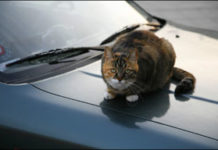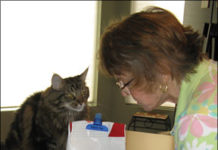How to Curb Destructive Scratching
Not long after youve invested in new furniture, your cat picks her favorite spot. And its not where she wants to take a nap, either. Its the place shes chosen to give herself a pedicure, and soon that beautiful new sofa looks like its gone through a shredder. Why Cats Claw. You may notice your cat flexing her nails when she first gets up and stretches or suddenly stop to sink her nails into the wall-to-wall carpeting as she crosses a room. She may scratch at the end of a burst of energy after playing with her favorite toy. Fabrics, carpet, wood, cardboard anything in your house made of materials your cat can sink her nails into can become a target for her clawing. "Clawing helps them shed the outer layer of their nails," says Katherine Houpt, VMD, PhD, and the James Law professor of Behavior Medicine at Cornell Universitys College of Veterinary Medicine. In addition to having a practical purpose, clawing serves a more esoteric function. Cats indoors and out leave olfactory and visual signals on the surfaces of whatever material they claw. "Indoors, cats leave the marks on well-traveled areas like doorways or in more obvious locations like the ends of a sofa," says Dr. Houpt.
A Ban on Declawing?
The San Francisco Commission of Animal Control and Welfare wants the city to ban the declawing of cats. In a July hearing, the Commission voted 5 to 1 to recommend that the citys Board of Supervisors adopt an ordinance to ban the practice. (It would exclude cases where declawing is necessary for a cats health.) If passed, San Francisco will be the second city in the U.S. with such an ordinance. West Hollywood, CA, banned the practice in 2003.
Ask Elizabeth: 08/09
I have been purring nearly my whole life so I should be an expert! However, like many feline characteristics, purring is mysterious - even to me! Let me share what my friends at the Cornell Feline Health Center have to say about purring. At its core, purring is a means of communication - but cats purr in a variety of situations: when they are comfortable and content, of course, but also when they are anxious, injured or ill. What, exactly, a cat is communicating in these various situations is open to interpretation.
Recognize Senility in Your Aging Cat
Thanks to advances in veterinary medicine, its not uncommon for a cat to live to the ripe old age of 20 - roughly the physiologic equivalent of age 93 in a human. Thats the good news. The bad news is that cats, like humans, become increasingly susceptible to age-related disease conditions as they grow old, and most of these disorders are bound to have an effect on an animals behavior. For example, arthritis is likely to cause an active cat to slow down dramatically as it transitions through its golden years; kidney and urinary tract disease may affect its litter box behavior; progressive periodontal disease and tooth loss may alter its eating habits; and progressive hearing problems may make a cat decreasingly responsive to its environment. In some cases, however, an elderly cats behavioral peculiarities will remain unattributable to any underlying disease condition. In such a case, the animal is apt to be diagnosed as "senile," a vague term used to describe an animal that exhibits physiologically inexplicable cognitive dysfunction, the outward signs of which resemble those associated with age-related dementia and Alzheimers disease in humans.
Do Cats Exhibit Vengeful Behavior?
Vacations are wonderful, but theres nothing like home sweet home. You drive home from the airport, excited at the thought of sleeping in your own bed, and seeing your beloved cat. And she does seem happy to see you, greeting you with enthusiasm and sharing a few cuddles. Then you go off to unpack, and there she goes - right into your suitcase, urinating on top of your folded clothes. To you, it may feel like your cat is angry because you left her - and this is the way shes making her feelings known. But can a cat really hold a grudge? Experts look at it in another way. Cats and Vengeance. Ask many cat companions, and they will say "yes." They swear that cats can and will be vengeful at times. Besides suitcase antics, people point out the times their cats bite them minutes, or even hours, after they did something their cat disliked - such as grooming it. But animal behaviorists disagree.
A Health Checklist to Perform at Home
The owner is the veterinarians eyes and hands away from the office," explains Fred Scott, DVM, PhD, interim director of Cornells Feline Health Center. For this reason, it is important to be familiar with the steps involved in doing an at-home mini-physical examination on your cat. This should supplement your cats twice yearly trips to the veterinarian. Performing an at-home physical examination is much easier than you might think; in fact, Dr. Scott points out, the examination should be a normal extension of the regular attention you give your cat.
Stressful Times Impact Our Pets, Too
To you ever wonder if any of the anxiety and tension you sometimes bring home can also affect your pets? These challenging economic times can indirectly be hard on our cats, too. Experts feel that cats will indeed react to changes in the emotional behavior of their owners. So, if we believe that cats can sense our stress - and we certainly are living in an era of increased worry and anxiety - it stands to reason that our cats are experiencing higher levels of stress, as well. At what point are our feline friends exposed to more stress then they can handle?
Be A Good Neighbor … With Pets
Outdoor hazards - such as dogs, coyotes, cars, and disease - face cats that are allowed to roam outdoors. Most veterinarians, including those at the Cornell Universitys College of Veterinary Medicine, strongly recommend that cats be kept indoors. But if your cat does travel beyond your front door, its likely to wander onto the property of your neighbors. While some people will welcome feline visitors, others wont. What can you do to honor your cats need to roam - and respect your neighbors rights, too? To choose the best method for dealing with a problem, observe your cats behavior carefully to clarify the issue. For example, one womans cat coexisted peacefully with a backyard bird feeder until it suddenly killed three birds in one week. Upon investigation, she discovered that melting snow had left a depression in the ground. The depression prevented the birds from seeing the cat when it crouched in the hole, making them vulnerable to attack. Once the hole was filled in, the birds were safe again.
Ask Elizabeth: 07/09
Thanks for responding in your February 2009 column to my question about night-time yowling. To answer your question, Decker is just 11 months old. A recent physical exam showed that he is in top form with no health problems. It was interesting to read all of the reasons why older cats may meow at night. Now Ill know what to do if Decker starts yowling at an advanced age, but in the meantime, I am hoping that we can get him to sleep through the night! I would like to take you up on your offer to expand on ways to get younger cats onto a more appropriate daytime/nighttime schedule.
Keep Your Cat Safe During the Hazardous Months of Summer
Your cats safety and good health should be a year-round priority. And unless you keep your cat indoors all of the time, the challenge is likely to be most demanding during the summer months, when temperatures soar, and cats are more likely to wander from the secure confines of their homes. During extremely hot, humid weather, cats are increasingly vulnerable to heat exhaustion and dehydration. They are more prone to assault by fleas, ticks, and other parasites. They can be dangerously exposed to cancer-causing sun rays. And they are more likely to come in contact with such noxious substances as lawn chemicals and rotting garbage. Among the most severe of summertime risks facing the outdoor cat is the threat of being hit by a motor vehicle, says Christine Bellezza, DVM, a consultant at the Feline Health Center of Cornell Universitys College of Veterinary Medicine. "As the weather warms up," she points out, "cats tend to be outside more often. So theyre more likely to roam around, cross streets, and wander into the path of a car."
Ask Elizabeth: 06/09
The dark brown color of normal cat stool largely results from substances in the bile, a liquid produced in the liver that then empties into the first part of the small intestine. Bile aids in the digestion of fats and contains a number of substances, among which are breakdown products of aged red blood cells. These breakdown products impart the yellow color that is characteristic of bile. As these yellow pigments pass in stool on the way out of the body, bacteria residing in the large intestine break them down further, so their original yellow color is changed to a dark brown.
Short Takes: 05/09
Canaries and cats have another thing in common - besides an aversion or appetite, respectively, for one another. Like the legendary canaries in the coalmines, cats can be "Sentinels for Public Health," the title of an article in Veterinary Clinics of North America (Vol. 39, Issue 2). The journal says "companion animals have an especially valuable role as sentinels because of their unique place in peoples lives, with exposure to similar household and recreational risk factors as those for the people who own them." For example, cats suffering plumbism (lead poisoning) "have led to the discovery and successful treatment of lead toxicity in children living in the same household," according to the journal. When chemicals leaked from a Georgia plant in 2006, public-health workers went door to door, asking if cats and dogs were suffering respiratory effects. And of course, cats and dogs were the first to be affected in 2007 by melamine-contaminated wheat gluten from China. The subsequent investigation stopped chicken and pork that had been fed contaminated gluten from reaching the human food supply.















